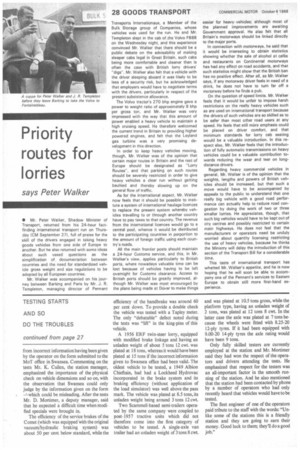Featherstone Wolve rhampton
Page 29

Page 30

If you've noticed an error in this article please click here to report it so we can fix it.
by Paul Brockington • A deficiency in the brakes of a 1956 Leyland Comet 2,000-gal four-wheeled tanker was the only disqualifying defect that MoT examiners recorded at the Wolverhampton, Featherstone test station on Tuesday. The tanker was the first vehicle due for testing and the start was delayed because the mechanic in charge did not have a safety certificate.
Three rigid vehicles and two semi-trailers were tested and the only hold-ups resulted from incorrect information having been given by the operator on the form submitted to the MoT office in Swansea. Commenting on the tests Mr. K. Cullen, the station manager, emphasized the importance of the physical check on vehicle dimensions and so on, with the observation that Swansea could only judge by the information given on the form which could be misleading. After the tests Mr. D. Mortimer, a deputy manager, said that he expected a difficult time when modified specials were brought in.
The efficiency of the service brakes of the Comet (which was equipped with the original vacuum/hydraulic braking system) was about 50 per cent below standard, while the efficiency of the handbrake was around 60 per cent down. To provide a double check the vehicle was tested with a Tapley meter. The only "debatable" defect noted during the tests was "lift" in the king-pins of this vehicle.
A 1956 ERF twin-steer lorry, equipped with modified brake linkage and having an unladen weight of about 5 tons 12 cwt. was plated at 18 tons, whereas it would have been plated at 15 tons if the incorrect information given to Swansea office had been valid. The oldest vehicle to be tested, a 1949 Albion Chieftain, had had a Lockheed Hydrovac incorporated in the brake system and its braking efficiency (without application of the load simulator) was well above the pass mark. The vehicle was plated at 8.5 tons, its unladen weight being around 3 tons 12 cwt.
Two Scammell-based semi-trailers operated by the same company were coupled to post-1957 tractive units which did not therefore come into the first category of vehicles to be tested. A single-axle van trailer had an unladen weight of 3 tons 8 cwt. and was plated at 10.5 tons gross, while the platform type, having an unladen weight of 2 tons, was plated at 12 tons 8 cwt. In the latter case the axle was plated at 7 tons because the wheels were fitted with 8.25-20 12-ply tyres. If it had been equipped with 9.00-20 14-ply tyres the axle rating would have been 9 tons.
Only fully skilled testers are currently employed at the station and Mr. Mortimer said they had won the respect of the operators and drivers attending the tests. He emphasized that respect for the testers was an all-important factor in the smooth running of the station. And he also mentioned that the station had been contacted by phone by a number of operators who had only recently heard that vehicles would have tobe tested.
The fleet engineer of one of the operators paid tribute to the staff with the words: "Unlike some of the stations this is a friendly station and they are going to earn their money, Good luck to them; they'll do a good job."












































































































